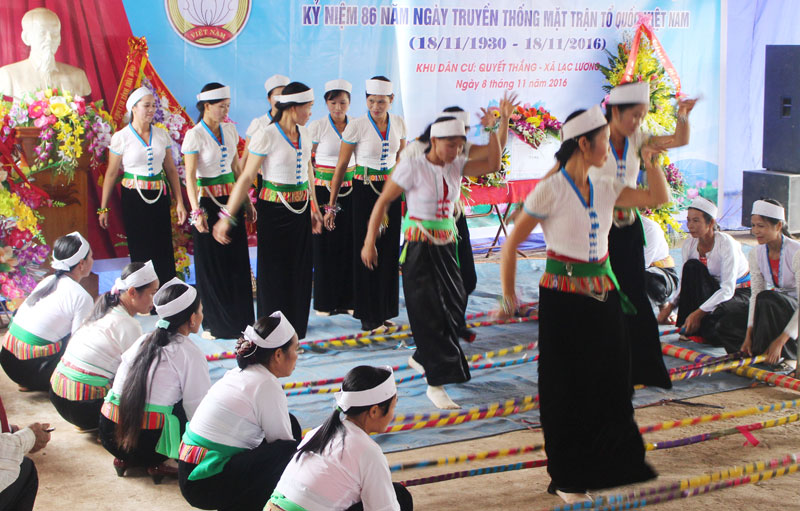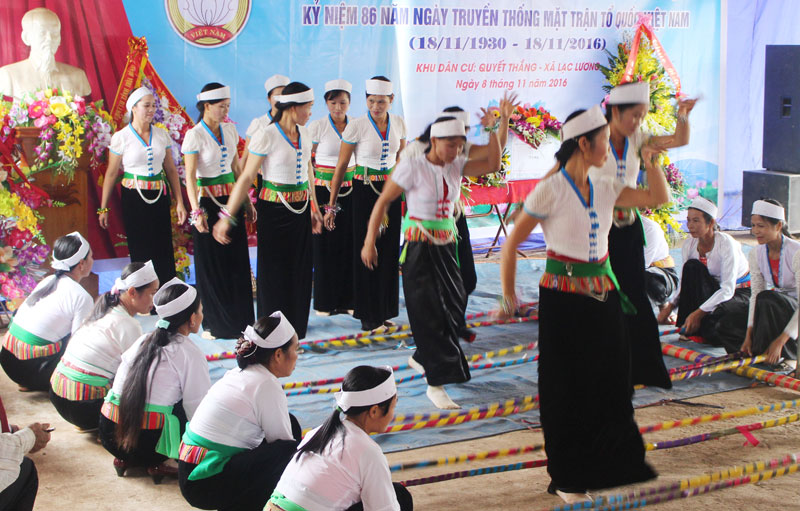
(HBO) - Visiting Hoa Binh in spring days, everyone is immersed in the bustling gong of festivals full of cultural identity, enjoy the national dishes and sip the wine jar in the stilt house. Not only that, this place also lures visitors with the bamboo dancing boasted, so that anyone who has been immersed with it would never forget.

Bamboo Dance becoming a form of cultural
exchange, linking ethnic communities. Photo taken at Quyet Thang hamlet, Lac
Luong commune (Yen Thuy).
Bamboo dance came to the people who grow up
in Hoa Binh very naturally. Over the years, the styles of bamboo dance have
been ingrained in the people’s minds. There are some cultural values that exist
in such a special way like that so it is easy to understand why bamboo dancing
is the typical and popular dance of Muong ethnic group.
The instruments needed for bamboo dancing are
two big trees, usually made of bambusa nutans, straight and long, which make up
the main stalls and many pairs of bamboo stalls with 3-4cm in diameter and 3-4m
in length. The local people use those to create tools for making sounds and
dance rhythm. In addition, everyday items such as bows, brocade towels, silk
towels are also put into the dance. Men are dancing with bows; ladies are
dancing with fans, silk scarves. Depending on each place, each cultivation and
living habits that people choose the suitable tools to dance with.
The concept of balance, harmony of bamboo
dance also follows certain rules. The dance team consists of a flapping group
and a dancing group. Each group can be from several couples to many couples,
the more couples there are, the richer and livelier the team is. However, the
number of men and women is always equal. The movement of the men should be
healthy to show the brave, the women are flexible, gentle and even movements of
the hands and legs shaking. The bamboo dance requires the dancers to feel the
music, hands and legs must be together into a unified point.
Bamboo dance of Muong ethnic people
originated from a simple folk game that has now become the art of dance. The
start was the game of pestle beating and stick beating. Throughout the
development process, the art of bamboo dance has become much richer, livelier
with high artistic content.
Mr. Bui Van Khan, a bamboo dancing artist in
Ai village (Phong Phu commune, Tan Lac district) said: According to the
migration process, Muong ethnic people live closer to other ethnic groups,
bamboo dancing has become a form of cultural exchange. The dance is simple,
easy to learn but exciting, has made a bridge among the peoples of the ethnic
groups.
Under the stilt house, beside the stream, the
sounds of the bamboo dance still ring when friends far away can find. The dance
has gone through many ups and downs with many changes are now bustling in
laughter, cheerful echo, will remain forever with the village, with mountains
and forests of the northwest area.
With an increasingly vibrant and widespread emulation movement aimed at building cultured residential areas and cultured families, Yen Thuy District has been making steady progress toward improving both the material and spiritual well-being of its people, while fostering a civilized, prosperous, beautiful, and progressive community.
Once lacking recreational spaces and community facilities, Residential Group 2 in Quynh Lam Ward (Hoa Binh City) has recently received attention for the construction of a new, spacious, and fully equipped cultural house. The project followed the model of state support combined with public contributions in both labor and funding.
The "All people unite to build cultural life" movement, which has been effectively integrated with Kim Boi district’s socio-economic development goals, is fostering a lively spirit of emulation across local residential areas, hamlets, villages, public agencies, and enterprises. In addition, through the initiative, traditional cultural values are being preserved and promoted, while community solidarity and mutual support in poverty reduction and economic development are being strengthened.
A working delegation of the Hoa Binh provincial People’s Committee led by its Permanent Vice Chairman Nguyen Van Toan on June 11 inspected the progress of a project to build the Mo Muong Cultural Heritage Conservation Space linked to tourism services in Hop Phong commune, Cao Phong district.
Born and growing in the heroic land of Muong Dong, Dinh Thi Kieu Dung, a resident in Bo town of Kim Boi district, in her childhood was nurtured by the sweet lullabies of her grandmother and mother. These melodies deeply imprinted on her soul, becoming an inseparable part of her love for her ethnic group's culture. For over 20 years, this love for her hometown has driven Dung to research, collect, and pass down the cultural values of the Muong people to future generations.
In the final days of May, the Ethnic Art Troupe of Hoa Binh Province organized performances to serve the people in remote, mountainous, and particularly disadvantaged areas within the province. These were not just ordinary artistic shows, but they were the meaningful journeys aimed at spreading cultural values, enhancing the spiritual life of the people and contributing to the preservation of ethnic minority cultural identities.



